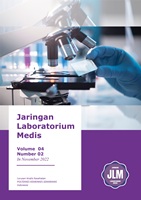Perbandingan Berbagai Metode Pengecatan Spora pada Bacillus Cereus
Diterbitkan 2022-11-01
Kata Kunci
- Bacillus Cereus,
- Spores,
- Painting Method
Cara Mengutip
Abstrak
Endospor dibentuk oleh beberapa anggota genera bakteri gram positif, seperti Bacillus dan Clostridium. Spora sangat resisten struktur; tahan terhadap suhu air mendidih selama dua jam atau lebih. Mereka mengandung sedikit air dan menunjukkan sangat sedikit reaksi kimia. lingkungan eksternal menguntungkan akan menyebabkan spora rusak dan vegetative sel muncul untuk tumbuh dan berkembang biak. Mengidentifikasi patogen pembentuk endospore adalah penting dalam mikrobiologi makanan dan medis. Namun, spora mengandung banyak lapisan pelindung, yang tidak dapat ditembus dengan mudah oleh noda pengecatan sederhana atau teknik pewarnaan Gram. Oleh karena itu perlu aplikasikan panas untuk membantu penetrasi warna, dengan beberapa metode pengecatan Gram, pengecatan spora metode fluorescent, pengecatan spora metode Schaeffer and Fulton dan pengecatan spora metode Klien. Hasil pengecatan metode fluorescent memiliki hasil yang lebih baik akan tetapi memerlukan peralatan yang jauh lebih mahal pengunaan mikroskop fluorescent dengan pertimbangan fasilitas yang harus disediakan pengecatan metode Schaeffer and Fulton sebagai alternative bila tidak memiliki fasilitas tersebut .
Referensi
- Ehling-Schulz, M., Lereclus, D., and Koehler, T. M. (2019). The Bacillus cereus group: Bacillus species with pathogenic potential. Microbiology spectrum, 7(3), 7-3.
- Tuipulotu, D. E., Mathur, A., Ngo, C., & Man, S. M. (2021). Bacillus cereus: epidemiology, virulence factors, and host–pathogen interactions. Trends in Microbiology, 29(5), 458-471.
- Ehling-Schulz, M., Frenzel, E., and Gohar, M. (2015). Food–bacteria interplay: pathometabolism of emetic Bacillus cereus. Frontiers in microbiology, 6, 704.
- Oktari, A., Supriatin, Y., Kamal, M., & Syafrullah, H. (2017, February). The bacterial endospore stain on Schaeffer Fulton using variation of methylene blue solution. In Journal of Physics: Conference Series (Vol. 812, No. 1, p. 012066). IOP Publishing.
- Smith, A. C., & Hussey, M. A. (2005). Gram stain protocols. American Society for Microbiology, 1, 14.
- Thairu, Y., Nasir, I. A., and Usman, Y. (2014). Laboratory perspective of gram staining and its significance in investigations of infectious diseases. Sub-Saharan African Journal of Medicine, 1(4), 168.
- Gurung, R., Shrestha, R., Poudyal, N., & Bhattacharya, S. K. (2018). Ziehl Neelsen vs. Auramine staining technique for detection of acid fast bacilli. Journal of BP Koirala Institute of Health Sciences, 1(1), 59-66.
- Schichnes, D., Nemson, J. A., and Ruzin, S. E. (2006). Fluorescent staining method for bacterial endospores. MICROSCOPE-LONDON THEN CHICAGO-, 54(2), 91.
- Driks, A. (1999). Bacillus subtilis spore coat. Microbiology and Molecular Biology Reviews, 63(1), 1-20.
- Oktari, A., Supriatin, Y., Kamal, M., and Syafrullah, H. (2017). The Bacterial Endospore Stain on Schaeffer Fulton using Variation of Methylene Blue Solution. In Journal of Physics: Conference Series (Vol. 812, No. 1, p. 012066). IOP Publishing.

